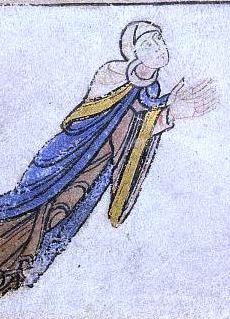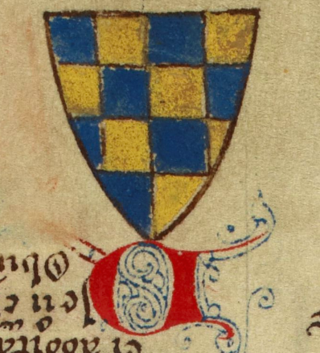
Arundel Castle is a restored and remodelled medieval castle in Arundel, West Sussex, England. It was established by Roger de Montgomery in the 11th century. The castle was damaged in the English Civil War and then restored in the 18th and early 19th centuries by Charles Howard, 11th Duke of Norfolk. Further restoration and embellishment was undertaken from the 1890s by Charles Alban Buckler for the 15th Duke.
Roger Bigod was a Norman knight who travelled to England in the Norman Conquest. He held great power in East Anglia, and five of his descendants were earls of Norfolk. He was also known as Roger Bigot, appearing as such as a witness to the Charter of Liberties of Henry I of England.

Adeliza of Louvain was Queen of England from 1121 to 1135 as the second wife of King Henry I.
Hugh Bigod, 1st Earl of Norfolk (1095–1177) was the second son of Roger Bigod, sheriff of Norfolk and royal advisor, and Adeliza, daughter of Robert de Todeni.

Earl of Arundel is a title of nobility in England, and one of the oldest extant in the English peerage. It is currently held by the Duke of Norfolk, and it is used by his heir apparent as a courtesy title.

William de Warenne, 5th Earl of Surrey was the son of Hamelin de Warenne and Isabel, daughter of William de Warenne, 3rd Earl of Surrey. His father Hamelin granted him the manor of Appleby, North Lincolnshire.

The House of Mowbray was an Anglo-Norman noble house, derived from Montbray in Normandy and founded by Roger de Mowbray, son of Nigel d'Aubigny.

William d'Aubigny, 3rd Earl of Arundel, also called William de Albini IV, was an English nobleman, a favourite of King John, and a participant in the Fifth Crusade.

Castle Rising is a village and civil parish in the English county of Norfolk. The village is situated some 8 kilometres (5 mi) north-east of the town of King's Lynn and 60 kilometres (37 mi) west of the city of Norwich. The River Babingley skirts the north of the village separating Castle Rising from the site of the lost village of Babingley.

Burton Lazars is a village and former civil parish, now in the parish of Burton and Dalby, in the Melton district, in the county of Leicestershire, England. It is two miles (3 km) south-east of Melton Mowbray, having a population of c.450 in 2015. It is the site of the remains of the English headquarters of the military and hospitaller Order of Saint Lazarus.

William d'Aubigny, 2nd Earl of Arundel, also called William de Albini III, was the son of William d'Aubigny, 1st Earl of Arundel and Adeliza of Louvain, widow of Henry I of England.
William d'Aubigny, 4th Earl of Arundel, also known as William de Albini V was the eldest son of William d'Aubigny, 3rd Earl of Arundel and Mabel of Chester, daughter of Hugh de Kevelioc, 3rd Earl of Chester and Bertrade de Montfort of Évreux. He became Earl of Arundel and Earl of Sussex on 30 March 1221. He was buried at Wymondham Abbey, Norfolk. There is no evidence that he married or had children. He was the Chief Butler of England and was succeeded by his brother, Hugh.
Sir Roger de Mowbray was an Anglo-Norman magnate. He had substantial English landholdings. A supporter of King Stephen, with whom he was captured at Lincoln in 1141, he rebelled against Henry II. He made multiple religious foundations in Yorkshire. He took part in the Second Crusade and later returned to the Holy Land, where he was captured and died in 1187.
The Battle of Fornham was fought during the Revolt of 1173–1174.
William FitzAlan (1085–1160) was a nobleman of Breton ancestry. He was a major landowner, a Marcher lord with large holdings in Shropshire, where he was the Lord of Oswestry, as well as in Norfolk and Sussex. He took the side of Empress Matilda during the Anarchy and underwent considerable hardship in the Angevin cause before regaining his lands and former status. William's younger brother, Walter fitz Alan, became ancestor of the royal House of Stuart.
William d'Aubigny, sometimes William de Albini, was an Anglo-French baron and administrator who served successive kings of England and acquired large estates in Norfolk. From his title of Butler to King Henry I of England, he was called William d'Aubigny Pincerna to distinguish him from other men of the same name.
Sussex in the High Middle Ages includes the history of Sussex from the Norman Conquest in 1066 until the death of King John, considered by some to be the last of the Angevin kings of England, in 1216. It was during the Norman period that Sussex achieved its greatest importance in comparison with other English counties. Throughout the High Middle Ages, Sussex was on the main route between England and Normandy, and the lands of the Anglo-Norman nobility in what is now western France. The growth in Sussex's population, the importance of its ports and the increased colonisation of the Weald were all part of changes as significant to Sussex as those brought by the neolithic period, by the Romans and the Saxons. Sussex also experienced the most radical and thorough reorganisation of land in England, as the Normans divided the county into five tracts of lands called rapes. Although Sussex may have been divided into rapes earlier in its history, under the Normans they were clearly administrative and fiscal units. Before the Norman Conquest Sussex had the greatest concentration of lands belonging to the family of Earl Godwin. To protect against rebellion or invasion, the scattered Saxon estates in Sussex were consolidated into the rapes as part of William the Conqueror's 'Channel march'.








